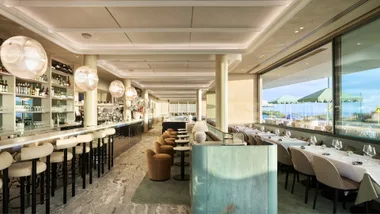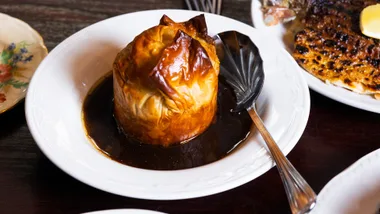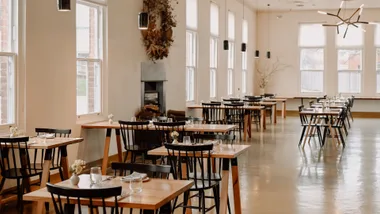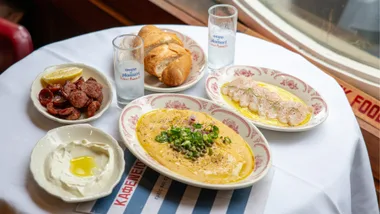Spice Temple
10 Bligh St, Sydney, NSW, (02) 8078 1888, spicetemple.com.au.
Cards AE DC MC V.
Open Lunch Mon-Fri noon-3pm, dinner Mon-Sat 6pm-11pm.
Prices Entrées $12-$29, main courses $19-$59 (live seafood at market price), desserts $14-$16.
Noise Managed buzz.
Vegetarian Three entrées, two mains.
Wheelchair access Yes.
Plus Chinese food like you’ve rarely seen it.
Minus Are they toning down the spice?
You really don’t see the word “numbing” on menus often enough. If you’ve got a bad restaurant habit – a five-restaurants-a-week problem – you start to develop a resistance to certain terms. Context is everything of course, but “crispy”, with a Y, is right up there, as are “jus” and “truffle oil”. “Numbing” is definitely a new one on me, but it’s easy to miss it on the Spice Temple menu among the 18 or so instances of the word “chilli”. Some of them are even printed in red just in case you missed them. This is the first of two restaurants Neil Perry is opening on the same city-centre site, the other being Rockpool Bar & Grill, the Sydney port of his successful Vegas-style steakhouse, which throws its doors open right about now. With so much Perry news, you could be forgiven for thinking you’ve heard quite enough from the chap with the ponytail for now, thank you very much. So we’re not going to talk about him. We’re going to talk about the food. And there’s lots to say.
As you step down into the basement off Bligh Street in the city, the scent of temple incense announces that this is a modern Asian restaurant. The steps open onto a reception area picked out with a heart-shaped spotlight, hemmed in by a small lightbox bar and columns papered with pages of Chinese books. Beyond it is the dining area, a square within the larger square of the room, bordered by hanging slats of painted timber. Off-white and tipped in red, they look as though they’ve been torn from a matchbook. It’s a pleasantly Buddha-free space: the Asian accent comes partly from the swirly carpet (evoking the Silk Road and your local Chinese in equal parts) and partly from the series of moody portraits on the walls. I’m not sure how I feel about them. Rockpool, with its fish focus, has pictures of fish and fishing. Rockpool Grill, a steakhouse, has pictures of cattle. Spice Temple has… photographs of Asian women. These Spice girls are models, by the look of them – something about the studied un-smiles gives it away. They seem a little odd in a restaurant run by a white guy, but are certainly a talking point.
If you’re familiar with Alan Yau’s Hakkasan in London, you might see similarities here in the way the hipster-magnet basement space has been divided into multiple sections, with the bar off to one side. The front entrance would be discreet were it not for the door, which is faced with a flush-set LCD screen (perfect for a Max Headroom-esque video-loop of Neil Perry hawking the restaurant’s delights, Dixon Street-style, should he need to drum up extra business). The music has been “curated” by Anton Monsted, the chap who produced the tunes for the camp-tacular Australia, and is a cut above your usual. The food is best shared – four is good, but a table of six or eight is ideal – and so the room plays host to many a convivial group booking. It’s as much a part of the Chinese restaurant vibe as any other element of the design.
This re-orienting of the restaurant picture of the Orient is appropriate. Spice Temple is a Chinese restaurant, but takes its cues from cuisines other than the Australian mainstay of Cantonese. Yunnan, Jiangxi, Guangxi and Xinjiang are among the influences listed on the menu, but it’s Sichuan and Hunan, two of the People’s Republic’s most incendiary culinary traditions, that appear to be best represented. Sichuan is characterised by the generous deployment of chilli and Sichuan pepper – not a true peppercorn, but the seeds of a prickly ash, which burn cool in the mouth, making the lips and mouth tingle. Hunanese food is all about the heavy, the sour, the hot and the salty. Mao Zedong hailed from the province, and said that to be a revolutionary you need to eat chilli. There’s enough here to foment all the rebellion you can imagine, and even more garlic still. Maybe that explains the incense.
“Stinking” or “funny smelling” tofu (as it’s usually translated), a Hunanese classic, doesn’t make an appearance on the menu, but there’s no shortage of arrestingly named dishes. “Hot and numbing chicken” grabs the eye, and the palate. It’s thick slices of cold chicken, poached Chinese-style so the flesh has a dense, almost jellied texture, and it sits dressed in sesame seeds in a slick of nutty sauce which lives up to the name admirably. The mouthfeel is extraordinary. Poultry features extensively, and is generally handled well. Tea-smoked chicken is burnished of skin and the smoke flavour is attractively haunting, with none of the acridity that can foil the genre. “Three shot chicken” doesn’t really set the world on fire. The waiters bring a claypot to the table on a little butane hotplate. It’s fired up, you dump in shots of beer, chilli oil and soy, and the hotpot of thighs simmers away. The dish itself is okay, but the presentation comes off gimmicky in a room like this.
Another of the more unusual-sounding birds is right up there in the this-rocks stakes: stir-fried quail with peanuts on steamed egg custard. That’s a savoury custard, you’ll be pleased to know, and it’s like a creamy cloud of feather-light scrambled egg topped with a layer of sang choi bau-esque minced quail and chopped peanuts. It’s as interesting texturally as it is damned tasty.
Lamb, a meat which proverbially disgusts Cantonese epicures, is also here in abundance. The lamb dumplings, little crisp-bottomed potstickers laced with fennel seed, aren’t bad, but the lamb and cumin pancakes, thin and crunchy renditions of the entrée seen at many a Muslim Chinese Sydney restaurant, have an airy elegance, lifted by a scattering of flake salt, that sets them apart. And then there’s the shredded cold lamb shoulder. It sounds terribly prosaic, but the addition of salted chilli brings it vividly to life (if you saw the recipe in March’s GT, you’re probably hooked already).
Right now you might be thinking gee, this all sounds fine, but how can you enjoy your meal with all the screams of agony around you? But it’s not that sort of restaurant. There’s heat here, certainly, what with all the dried, fresh, smoked, salted, pickled, fermented and roasted chillies, and the kitchen has a battery of chilli sauces and relishes at its disposal should you want to take things up a notch, but the general theme is spice rather than super-spicy, with the kitchen usually opting for complexity and rounded richness over straight-up pain and anguish. The red-glowing dishes should be approached with care by total chilli novices, but if you’re a regular patron of Sydney’s Asian restaurants, you’re not going to encounter much that will take your head off at the neck in the way that something from Spice I Am or Sailors Thai might.
Some of the less exciting dishes aren’t failures of technique or lost in translation; they just don’t burn as bright. File the leatherjacket fillets swimming in Sichuan pepper and oil, or the surprisingly crisp broccolini with house-made oyster sauce, under this heading. The gradual lessening of the spice intensity over the course of several visits is something to keep an eye on, too. But they’re blips on a radar that’s otherwise presenting a picture of some of the most interesting restaurant dining in town today.
Die-hards may question the value in the likes of the $59 beef fillet in chilli-blackened broth (it’s a surprisingly flattering treatment for quality meat), and others will talk of superior Chinatown versions of classics such as the silken tofu with preserved egg. But as a package, Spice Temple blows the competition out of the water. Many of us will opt, quite sensibly, for beer or tea with these flavours, but the hundred-bottle wine cellar is well-suited to the food and price-point, with an emphasis on fruit-driven rieslings, sauv blancs, grüners, gris, pinots, GSMs and other spice-friendly reds from around the world. The tea list is definitely more than set dressing, and the cocktails, though tending a bit fruitier than you may expect, are a valid drawcard. (Bring on the bar menu.)
With service that’s generally (though not uniformly) impressive, tangibly well-sourced raw produce (check out the stir-fried king prawns with salted duck egg, the steamed blue eye fillet with pickled green and salted red chilli, or the fried five-spice squid, crunchy with fennel seed and Sichuan pepper), and considered, flavour-appropriate desserts (a snowy watermelon granita, say, or a mango mousse given punch with a sesame seed-caramel crisp) that are a relief after all the salt, smoke and spice, Spice Temple is in a class of its own. Being comfortably numb never felt so good.
 Jason Loucas
Jason Loucas










